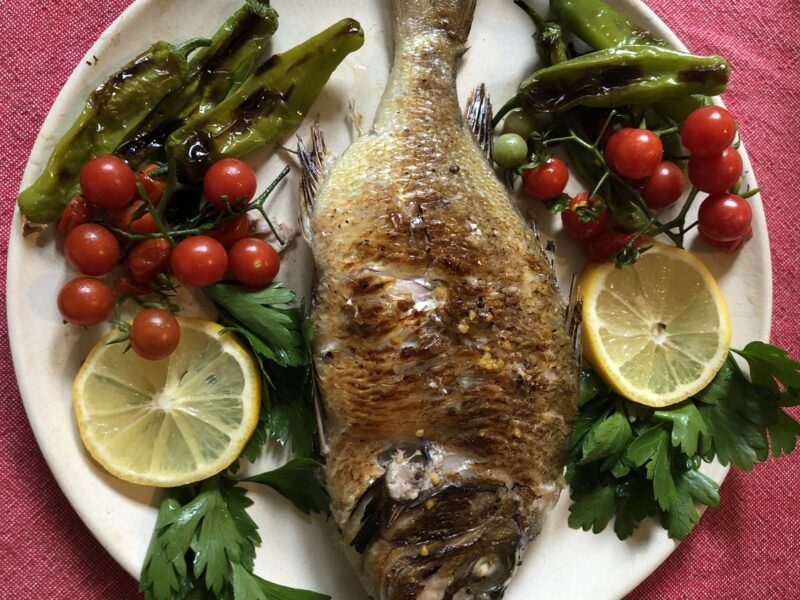

Once at a Chinese restaurant, I asked the waiter what the clear, rubbery substance was floating around in my soup.
“Shark fin,” he replied. My son, Kesha, who witnessed this fiasco, and is never one to miss an opportunity, burst out laughing. “Busted! Miss environmentalist eats shark fins!”
But to be fair, choosing sustainable fish is a tricky business, even under the best of circumstances. Is farm-raised bad? Depends on the farm. Depends on the fish. Is your favorite fish on the “Avoid” list? Or was that last week? What is the wrong type of type of fishing net, and who even knows net design anyway?
It doesn’t have to be this complicated.
When you want sustainable, fresh fish, just go local. Wild caught and locally processed fish are strictly regulated and use little fossil fuel getting to us. There’s an abundant variety on the East End, and unlike the 46 percent of mislabeled fish from abroad, you actually know what you’re eating. Something I always enjoy.
The jet-setting lifestyle of imported fish is a disaster on a few fronts. On average, they’re handled by 16 different distributors before reaching the store. This epic journey causes massive amounts of carbon emissions that contribute to global warming. Local seafood, on the other hand, goes through three distributors or less, and because East End fishermen stick close to shore, mostly taking day trips, they use a lot less fuel in travel
Then there’s the freshness factor. Unlike fish that are flash-frozen in large scale commercial fisheries before they travel the high seas, locally caught fish get to your plate faster.
While a third of international fisheries are harvesting at unsustainable levels, New York State has some of the strictest environmental regulations in the world. We have strict quotas on what species you can catch and how much you can catch. There are 450 different regulations alone regarding where you can fish.
“Between the DEC, NOAA and the various fishery councils, fishing is the seventh most regulated industry in the U.S.,” says Bonnie Brady, director of the Long Island Commercial Fishing Association. “New York is the gold standard for sustainability.”
The creepiest thing about imported fish is that, due to the opaque nature of management practices abroad, we’re basically eating mystery meat. Fish that hopscotch across countries all over the world lead to rampant mis-labelling. Donna Lanzetta of Manna Fish Farms in Hampton Bays notes, “Sixty percent of our fish come from China, only 2 percent of which are inspected. You basically don’t know what you’re getting.”
So what can us poor Sea Foodies do if we’re still hankering for a Chilean sea bass?
Substitute!
There’s a veritable buffet of local varieties out East, most of which easily substitute for international favorites. Year round, we can get fluke, tuna, swordfish, sea bass and monkfish, to name a few.
“We live on an island surrounded by water known for some of the best fishing in the world,” points out Kristen Gerbino, fisheries specialist at Cornell Cooperative Marine Program.
That said, I was skeptical that something called “monkfish” could really take the place of halibut, which will never be local.
So I did a little experiment on my friends. I subjected them to a “blind” taste test of local white fish mixed in with popular imports to see if people knew the difference. I also explained that I would be serving less popular local fish (or “underutilized” in fisherman parlance).
“Gee. That sounds so inviting,” said one of the victims. A more tactful guest suggested we do a potluck.
Of the 13 species of white fish that I served, people only guessed the name of the fish correctly 28 percent of the time. Nobody knew they were eating halibut and few guessed Chilean sea bass. Tile fish and cod got the highest ratings and branzino the lowest. Even the fishermen and serious cooks amongst us had trouble distinguishing one white fish from another. With subtle flavor differences, white fish seem to be all about how you cook it.
After talking to chefs, fishermen, seafood shop owners and the collective opinions of my brave friends, I discovered which local favorites would make a great substitute for imported halibut, cod, red snapper, branzino and Chilean sea bass, which due to overfishing in the 1990s is on the Monterey Bay Aquarium’s “Avoid” list.
Fluke (a.k.a. summer flounder), with its delicate flavor, replaces almost any white fish. black sea bass (a.k.a. sea bass), is plentiful but has a short season. According to Jermaine Owens of North Fork Seafood, sea bass are his favorite because their diet of shrimp and lobster make their meat delicious. Striped bass is local and popular with surfcasters. Mahi mahi and swordfish are not year round, but plentiful between June and November. Tuna come in four different local species, but yellowfin are the most sustainable.
One lesser known, but tasty, local is bluefish. With a similar flavor to mackerel, it’s a fish lover’s fish. Ryan Barth-Dwyer of Little Fish Restaurant in Southold says, “It’s firm, flaky, full of flavor and more affordable than most other wild caught fish.”
Then there’s monkfish, which is kind of the perfect fish. Abundant, year round and inexpensive, it’s called, “Poor man’s lobster,” but why compare when it’s so tasty in its own right?
“There’s a stigma because the fish is so ugly. It’s got little feet. It’s a monster!” says Barth-Dwyer. “But it’s a beautiful white, tender, sweet fish similar to halibut and cod, but much cheaper.”
The much under-appreciated porgy has a mild, lean and flaky meat. “You can catch them by the thousands year round,” according to Ryan Milfoil of Gosman’s Fish Market. They’re popular in French gastronomy, but because they’re not as well known here, they’re less expensive.
What’s available in the market is catch-as-catch-can and always fluctuating.
“What’s on offer depends on the weather, the season, and if the fisherman wants to go out that day,” says Milfoil. The key is to shift your thinking from ‘What am I in the mood for?’ to ‘What’s local and fresh right now?”
If the sticker price of some local fish makes your head spin, monkfish, porgies, hake and skate are inexpensive and have delicious, flaky white meat, proving that once again, doing the sustainable thing can save money.
A note about tilapia. Yes, the price is appealing, but when I asked fishermen for a tilapia substitute, most of them said, “Nothing,” because it’s, “Not a fish.” Or as a sign on the Amagansett Seafood Store more bluntly reads, “Stop Eating This Fake-Ass Fish.” While technically real, they’re farmed mostly on crowded fish farms in China, where the FDA revealed they’re fed livestock feces. So your call.
If you’ve read this far, you’re probably already a serious fish lover. But what do you do when persnickety little people or those crazy few who don’t like fish are joining your fish fry? Simple solution: tartar sauce. There’s no problem in the world that can’t be solved by a deep fried fish, smothered in spoonfuls of tartar sauce.
And about that shark incident for which I will live on forever ignominiously on my son’s Instagram? That was in Phnom Penh, Cambodia where I didn’t speak Cambodian, and the waiter didn’t speak English. In restaurants out where we live, ordering a sustainable fish is much easier. Says Amanda Jones of Inlet Seafood, a restaurant run by six local fishermen, “You just ask the waiter, ‘What came in off the boats today?’”
localfish.org: Click on “Species” tab for local fish and shellfish to find out what’s in season, what it tastes like and nutritional value of each fish. This CCE Marine Program initiative also offers recipes, cooking classes and a map of local seafood shops.
More Information:
Little Fish Restaurant: Chic new North Fork restaurant that focuses on sustainably caught wild fish, and includes lesser known local species. Chef Ryan Barth-Dwyer makes a great grilled butterflied fish, sourced from what’s caught that day. Also try the squid based fritto misto della casa and the monkfish tikka masala. Located at 50 North Sea Drive, Southold, littlefishnofo.com.
Minnow Restaurant: Every fish on the menu is local and sustainably harvested. Offers creative ways to serve up overlooked fish such as the tasty Sea Robin. Try their Bluefish pate. Also tasty are fennel and line-caught Porgy ceviche and the peppers stuffed with Mediterranean braised Porgy. Located at 650 1st Street, New Suffolk, minnowrestaurant.com.
Red Truck Sea Food: Small selection of local fish and shellfish right off their boat that day. Join them on Facebook for when and where the red truck will be. Based at 87 Foster Avenue, Hampton Bays, redtruckseafood.com.
Jermaine Owens of North Fork Seafood: Like having your own personal fish monger. Locally caught fish with a big focus on underutilized fish. He even fillets porgies and sea robin. Very reasonable prices. Call Owens directly to find out what’s available and place your order: 631-905-1123.
 More Posts from Jenny Noble
More Posts from Jenny Noble